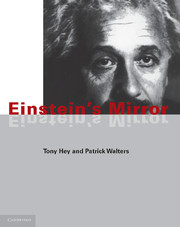Book contents
- Frontmatter
- Contents
- Preface
- 1 A revolution in time
- 2 The nature of light
- 3 Light and time
- 4 The ultimate speed
- 5 E = mc2
- 6 Matter and anti-matter
- 7 Little Boy and Fat Man: relativity in action
- 8 Down to earth
- 9 Warped space
- 10 The Big Bang, black holes unified fields
- 11 Afterword: Relativity and science fiction
- Appendix: Some mathematical details and derivations
- Chronology
- Glossay
- Quotations and sources
- Suggestions further reading
- Name index
- Subject index
- Plate section
11 - Afterword: Relativity and science fiction
Published online by Cambridge University Press: 05 March 2013
- Frontmatter
- Contents
- Preface
- 1 A revolution in time
- 2 The nature of light
- 3 Light and time
- 4 The ultimate speed
- 5 E = mc2
- 6 Matter and anti-matter
- 7 Little Boy and Fat Man: relativity in action
- 8 Down to earth
- 9 Warped space
- 10 The Big Bang, black holes unified fields
- 11 Afterword: Relativity and science fiction
- Appendix: Some mathematical details and derivations
- Chronology
- Glossay
- Quotations and sources
- Suggestions further reading
- Name index
- Subject index
- Plate section
Summary
The beginnings
The term ‘science fiction’ was first used by one of the founders of the modern genre, Hugo Gernsback. Gernsback, after whom the annual science fiction 'Hugo’ awards are named, was the founder of the Amazing Stories magazine in April, 1gz6.The slogan on the title page proclaimed its mission: 'Extravagant Fiction Today … Cold Fact Tomorrow'. Of course, few of the stories published in Amazing Stories lived up to this claim, but science fiction does have some notable successes to its credit over its relatively brief history. Two of the founding fathers of science fiction – H. G. Wells and Isaac Asimov – have already been mentioned in earlier chapters. In this final chapter, we shall examine the interplay between relativity and science fiction. We begin with Johannes Kepler, arguably the first writer of the genre.
Kepler was born in south-west Germany in a small town called Weil-der-Stadt. Kepler's first great work, A New Astronomy, was published in I 609, and it remains a landmark in the history of science. In it, Kepler formulated the first ‘natural laws’ – precise, verifiable statements about natural phenomena expressed in terms of mathematical equations. Arthur Koestler, in his marvellous book The Sleepwalkers, claims that it was Kepler's laws that 'divorced astronomy from theology and married astronomy to physics'. Unlike Copernicus, Galileo or Newton, Kepler did not attempt to disguise the way in which he arrived at his conclusions -all his errors and sidetracks are faithfully recorded along with his final revelation.
- Type
- Chapter
- Information
- Einstein's Mirror , pp. 240 - 257Publisher: Cambridge University PressPrint publication year: 1997



